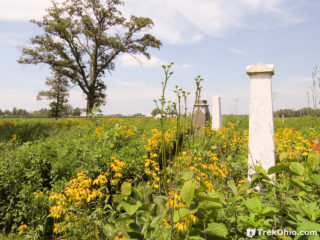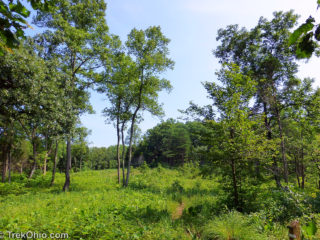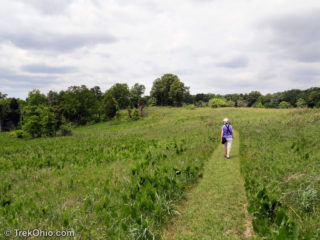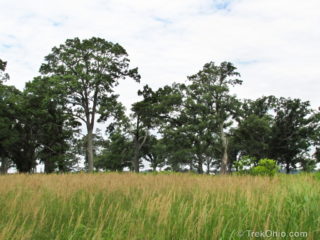 Smith Cemetery State Nature Preserve is a remnant of the Darby Plains prairie. While most of Ohio's prairies were converted into farmland, its status as a 19th-century pioneer cemetery meant that the land was never cultivated. Fortunately this has allowed it to preserve the original prairie grasses and wildflowers. The is a one acre preserve is located in Madison County.
We visited three prairie remnants west of Columbus on the same day: Smith Cemetery State Nature Preserve, Bigelow Cemetery Read more ➜
Smith Cemetery State Nature Preserve is a remnant of the Darby Plains prairie. While most of Ohio's prairies were converted into farmland, its status as a 19th-century pioneer cemetery meant that the land was never cultivated. Fortunately this has allowed it to preserve the original prairie grasses and wildflowers. The is a one acre preserve is located in Madison County.
We visited three prairie remnants west of Columbus on the same day: Smith Cemetery State Nature Preserve, Bigelow Cemetery Read more ➜ Smith Cemetery State Nature Preserve
 Smith Cemetery State Nature Preserve is a remnant of the Darby Plains prairie. While most of Ohio's prairies were converted into farmland, its status as a 19th-century pioneer cemetery meant that the land was never cultivated. Fortunately this has allowed it to preserve the original prairie grasses and wildflowers. The is a one acre preserve is located in Madison County.
We visited three prairie remnants west of Columbus on the same day: Smith Cemetery State Nature Preserve, Bigelow Cemetery Read more ➜
Smith Cemetery State Nature Preserve is a remnant of the Darby Plains prairie. While most of Ohio's prairies were converted into farmland, its status as a 19th-century pioneer cemetery meant that the land was never cultivated. Fortunately this has allowed it to preserve the original prairie grasses and wildflowers. The is a one acre preserve is located in Madison County.
We visited three prairie remnants west of Columbus on the same day: Smith Cemetery State Nature Preserve, Bigelow Cemetery Read more ➜  Last summer we visited two of Ohio's smallest state nature preserves: Bigelow Cemetery and Smith Cemetery. Within these two preserves are remnants of prairie that once extended over 5% of Ohio. Because both sites were 19th century cemeteries, they were undisturbed by the plowing that converted 99% of this rich, prairie soil into Ohio farmland. Today I will discuss the half-acre Bigelow Cemetery State Nature Preserve, and I'll save the nearby Smith Cemetery State Nature Preserve for a later post.
Last summer we visited two of Ohio's smallest state nature preserves: Bigelow Cemetery and Smith Cemetery. Within these two preserves are remnants of prairie that once extended over 5% of Ohio. Because both sites were 19th century cemeteries, they were undisturbed by the plowing that converted 99% of this rich, prairie soil into Ohio farmland. Today I will discuss the half-acre Bigelow Cemetery State Nature Preserve, and I'll save the nearby Smith Cemetery State Nature Preserve for a later post.  The Richard and Lucile Durrell Edge of Appalachia Preserve is situated 75 miles south of Cincinnati. The preserve system is managed jointly by the Museum of Cincinnati and the Nature Conservancy. Together its eleven different properties preserve some 16,000 acres of the western edge of the Appalachian Escarpment. Currently four of these properties feature hiking trails. We previously described the Joan Jones Portman Trail. Today we'll describe a hike we took mid-July on the Lynx Prairie Trail.
There
The Richard and Lucile Durrell Edge of Appalachia Preserve is situated 75 miles south of Cincinnati. The preserve system is managed jointly by the Museum of Cincinnati and the Nature Conservancy. Together its eleven different properties preserve some 16,000 acres of the western edge of the Appalachian Escarpment. Currently four of these properties feature hiking trails. We previously described the Joan Jones Portman Trail. Today we'll describe a hike we took mid-July on the Lynx Prairie Trail.
There  Between eight and four thousand years ago what later became Ohio experienced a prolonged drought. This allowed the drought-tolerant plants of the Great Plains to displace Ohio's more typical, water-loving plants. This eastward thrust of the prairie into Ohio has been referred to as a "prairie peninsula." The prairie peninsula encompassed nearly 400 square miles of the Darby Plains in western, central Ohio. Today only 1% of this prairie survives. There are a number of MetroParks in the Columbus and
Between eight and four thousand years ago what later became Ohio experienced a prolonged drought. This allowed the drought-tolerant plants of the Great Plains to displace Ohio's more typical, water-loving plants. This eastward thrust of the prairie into Ohio has been referred to as a "prairie peninsula." The prairie peninsula encompassed nearly 400 square miles of the Darby Plains in western, central Ohio. Today only 1% of this prairie survives. There are a number of MetroParks in the Columbus and  Chaparral Prairie is a 67-acres state nature preserve with a three-quarter mile loop trail. Located in Adams County, it preserves a rare prairie habitat. Prairies are defined by the type of vegetation that grows in them. In general these plants are drought-tolerant, fire-tolerant and shade-intolerant. They originated in America's Great Plains and moved eastward thousands of years ago during a centuries-long drought when this area was warmer than now. However as the climate cooled and normal rain
Chaparral Prairie is a 67-acres state nature preserve with a three-quarter mile loop trail. Located in Adams County, it preserves a rare prairie habitat. Prairies are defined by the type of vegetation that grows in them. In general these plants are drought-tolerant, fire-tolerant and shade-intolerant. They originated in America's Great Plains and moved eastward thousands of years ago during a centuries-long drought when this area was warmer than now. However as the climate cooled and normal rain  Daughmer Prairie Savannah is a 34 acre state nature preserve in Crawford County. It features a gravel parking lot, a kiosk, and 0.5 mile mown loop trail. And it is a very unusual place.
When early settlers first arrived in Ohio, most of the state was dense forest. However, when settlers reached the Sandusky Plains, they encountered a vast expanse of grassland with trees scattered here and there. When the trees in a grassland are so widely spaced that the canopy never closes, the
Daughmer Prairie Savannah is a 34 acre state nature preserve in Crawford County. It features a gravel parking lot, a kiosk, and 0.5 mile mown loop trail. And it is a very unusual place.
When early settlers first arrived in Ohio, most of the state was dense forest. However, when settlers reached the Sandusky Plains, they encountered a vast expanse of grassland with trees scattered here and there. When the trees in a grassland are so widely spaced that the canopy never closes, the